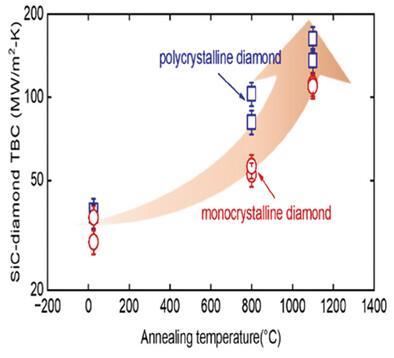当前位置:
X-MOL 学术
›
Adv. Electron. Mater.
›
论文详情
Our official English website, www.x-mol.net, welcomes your
feedback! (Note: you will need to create a separate account there.)
Interfacial Reaction Boosts Thermal Conductance of Room‐Temperature Integrated Semiconductor Interfaces Stable up to 1100 °C
Advanced Electronic Materials ( IF 5.3 ) Pub Date : 2024-10-14 , DOI: 10.1002/aelm.202400387 Xiaoyang Ji, Zifeng Huang, Yutaka Ohno, Koji Inoue, Yasusyohi Nagai, Yoshiki Sakaida, Hiroki Uratani, Jinchi Sun, Naoteru Shigekawa, Jianbo Liang, Zhe Cheng
Advanced Electronic Materials ( IF 5.3 ) Pub Date : 2024-10-14 , DOI: 10.1002/aelm.202400387 Xiaoyang Ji, Zifeng Huang, Yutaka Ohno, Koji Inoue, Yasusyohi Nagai, Yoshiki Sakaida, Hiroki Uratani, Jinchi Sun, Naoteru Shigekawa, Jianbo Liang, Zhe Cheng

|
Overheating has emerged as a primary challenge constraining the reliability and performance of next‐generation high‐performance (ultra)wide bandgap (WBG or UWBG) electronics. Advanced heterogeneous bonding of high‐thermal‐conductivity WBG thin films and substrates not only constitutes a pivotal technique for fabricating these electronics but also offers potential solutions for thermal management. This study presents the integration of 3C‐silicon carbide (SiC) thin films and diamond substrates through a surface‐activated bonding technique. Notably, following annealing, the interfaces between 3C‐SiC and diamond demonstrate an enhancement in thermal boundary conductance (TBC), reaching up to ≈300%, surpassing all other grown and bonded heterointerfaces. This enhancement is attributed to interfacial reactions, specifically the transformation of amorphous silicon into SiC upon interaction with diamond, which is further corroborated by picosecond ultrasonics measurements. After annealing at 1100 °C, the achieved TBC (150 MW m−2 K−1 ) is among the highest among all bonded diamond interfaces. Additionally, the visualization of large‐area TBC, facilitated by femtosecond laser‐based time‐domain thermoreflectance measurements, shows the uniformity of the interfaces which are capable of withstanding temperatures as high as 1100 °C. The research marks a significant advancement in the realm of thermally conductive WBG/substrate bonding, which is promising for enhanced cooling of next‐generation electronics.
中文翻译:

界面反应提高了室温集成半导体界面的热导率,可在高达 1100 °C 的温度下保持稳定
过热已成为限制下一代高性能(超)宽带隙(WBG 或 UWBG)电子产品可靠性和性能的主要挑战。高导热性 WBG 薄膜和衬底的先进异质键合不仅构成了制造这些电子设备的关键技术,而且还为热管理提供了潜在的解决方案。本研究介绍了通过表面激活键合技术将 3C-碳化硅 (SiC) 薄膜与金刚石衬底集成在一起。值得注意的是,退火后,3C-SiC 和金刚石之间的界面表现出热边界电导率 (TBC) 的增强,最高可达 ≈300%,超过了所有其他生长和键合的异质界面。这种增强归因于界面反应,特别是非晶硅在与金刚石相互作用时转化为 SiC,皮秒超声波测量进一步证实了这一点。在 1100 °C 退火后,获得的 TBC (150 MW m-2 K-1) 是所有键合金刚石界面中最高的。此外,通过基于飞秒激光的时域热反射测量,大面积 TBC 的可视化显示了能够承受高达 1100 °C 的温度的界面的均匀性。 这项研究标志着导热 WBG/基板键合领域的重大进展,有望增强下一代电子产品的冷却效果。
更新日期:2024-10-14
中文翻译:

界面反应提高了室温集成半导体界面的热导率,可在高达 1100 °C 的温度下保持稳定
过热已成为限制下一代高性能(超)宽带隙(WBG 或 UWBG)电子产品可靠性和性能的主要挑战。高导热性 WBG 薄膜和衬底的先进异质键合不仅构成了制造这些电子设备的关键技术,而且还为热管理提供了潜在的解决方案。本研究介绍了通过表面激活键合技术将 3C-碳化硅 (SiC) 薄膜与金刚石衬底集成在一起。值得注意的是,退火后,3C-SiC 和金刚石之间的界面表现出热边界电导率 (TBC) 的增强,最高可达 ≈300%,超过了所有其他生长和键合的异质界面。这种增强归因于界面反应,特别是非晶硅在与金刚石相互作用时转化为 SiC,皮秒超声波测量进一步证实了这一点。在 1100 °C 退火后,获得的 TBC (150 MW m-2 K-1) 是所有键合金刚石界面中最高的。此外,通过基于飞秒激光的时域热反射测量,大面积 TBC 的可视化显示了能够承受高达 1100 °C 的温度的界面的均匀性。 这项研究标志着导热 WBG/基板键合领域的重大进展,有望增强下一代电子产品的冷却效果。


















































 京公网安备 11010802027423号
京公网安备 11010802027423号